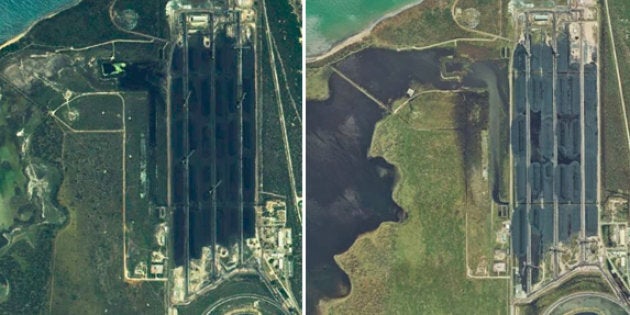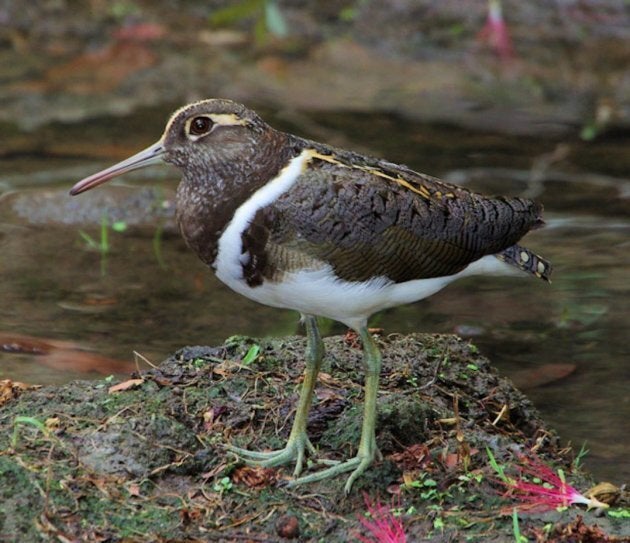
As the federal government makes a renewed push to clear the way for expanding Adani's controversial Carmichael coal mine, satellite images have emerged showing important wetlands blackened by coal dust from the company's Abbot Point coal terminal.
The Queensland government has responded to the images by announcing an investigation to determine whether the terminal made any unauthorised water releases into the nearby Caley Valley wetlands in the wake of Cyclone Debbie.
The Department of Environment and Heritage Protection says initial monitoring suggested no unauthorised releases had been made, but environmental groups have condemned the spill, which they say will have dire impacts on the sensitive wetlands.
We have no confidence that Adani will be able to manage the environmental impacts of the port expansion or any other aspect of its massive coal mining operation."
The satellite images show huge swaths of the wetland coated in black coal dust. If sufficiently severe and long-lasting, coal sediment risks polluting the waters and poisoning and suffocating marine life, according the Queensland's environment department.
The announcement comes the day after Prime Minister Malcolm Turnbull met with top level Adani executives in India to advocate for the launch of the controversial Carmichael mine. Turnbull reportedly assured Adani Group chairman Gautam Adani that the issue of Native Title would soon be resolved, clearing the way for the expansion to commence.
If it goes ahead, the $21 billion project would become Australia's largest coal mine and the Abbot Terminal port, owned by a subsidiary of Adani, would be significantly expanded to cope with the extra capacity.
Mackay Conservation Group coordinator, Peter McCallum, says the evident damage to the wetlands raises serious questions over what will happen when the port is expanded.
"Adani wants to build a new coal terminal at the port that will involve extensive dredging in Great Barrier Reef waters, then pile the waste rock and mud alongside these wetlands. That will put the wetlands and the reef under even greater threat," he said.

"It's obvious that Adani doesn't know how to manage its existing facilities in a way that will protect the wetlands, or perhaps the company just doesn't care."
"We have no confidence that Adani will be able to manage the environmental impacts of the port expansion or any other aspect of its massive coal mining operation."
The Mackay Conservation Group has written to the Queensland Environment Minister, Steven Miles, to request information on the amount of coal released into the wetlands, and what will be done to rehabilitate the wetlands.
"Nobody should be able to get away with causing harm as terrible as this without facing severe penalties," McCallum said.
It's unclear whether the Abbot Point Bulk Coal, owned by Adani, was in breach of its regulations in releasing the sediment-laden water, as the Queensland Government had issued it with a Temporary Emissions Licence (TEL) relaxing its conditions in the lead up to Cyclone Debbie.
I don't think that what you've got here -- dust blowing over a duck shooting pond -- is a major risk that means that we should be stopping Adani mine." - Barnaby Joyce
The TEL allowed Abbot Point Bulk Coal, owned by Adani, to more than triple the amount of sediment in water run-off in the wake of Cyclone Debbie -- from 30mg/L to 100mg/L.
"A TEL does not authorise environmental harm," a spokeswoman for the Department of Environment and Heritage Protection said in a statement.
"By comparison, the total suspended solids in central Queensland waterways following rainfall events typically exceed 1000mg/L."
But regardless of whether the company breached government regulations, "significant damage" to the wetlands was "highly likely", James Cook University professorial research fellow in water quality studies, Professor Jon Brodie, told the Brisbane Times, raising the issue of further environmental impact when the planned Carmichael Mine is built.
Deputy Prime Minister Barnaby Joyce has dismissed claims that the Abbot Point port poses a serious environmental threat, blaming the coal sediment on Cyclone Debbie and labelling the wetlands a "swamp" built for duck shooters.
"If you go for zero risk, then we can just pack up and go home," he told RN on Tuesday morning.
"You've got to mitigate the risk, but I don't think that what you've got here -- dust blowing over a duck shooting pond -- is a major risk that means that we should be stopping Adani mine."
Joyce wants the Government to not only approve the mine's construction, but to also fund a $900 million concessional loan to Adani to fund the railway linking the mine to the Abbot Point terminal.
But Joyce's own government appears to dispute Joyce's description of the 5,000 hectare wetlands as an abandoned swamp.

While acknowledging it was formerly a water fowl hunting area, the Australian government's Department of Environment and Energy website say it is now "an outstanding example of wetlands".
"Permanent water, a wide range of wetland habitats, very rich food resources and sheltered roosting and breeding sites cause the site to be exceptionally important for waterbirds," the site reads.
It also notes that its environmental importance is such that it is listed under the Ramsar Convention -- meaning it's considered a wetland of international importance.
The Mackay Conservation Group says the Caley Valley wetlands are home to over 40,000 shorebirds during the wet season, including a significant population of the endangered Australian painted snipe.
ALSO ON HUFFPOST AUSTRALIA